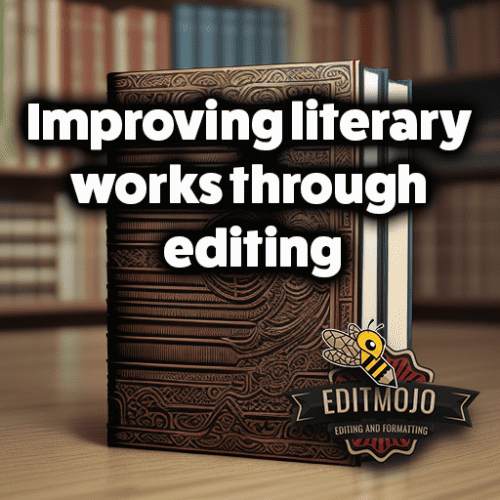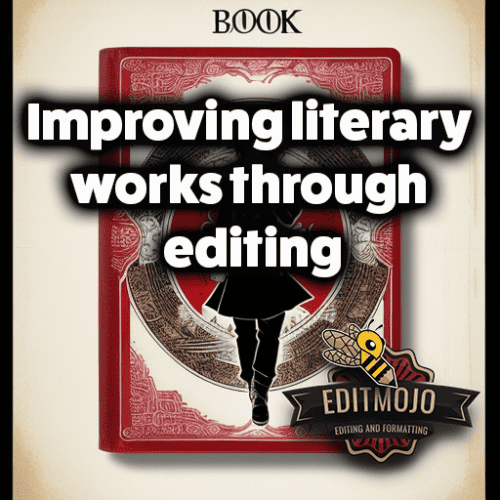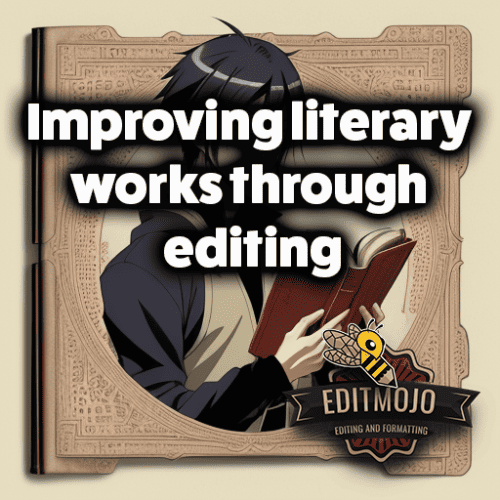Improving literary works through editing
Improving literary works through editing. It’s been said that great writing isn’t written, it’s re-written. But what is this ‘re-writing’, if not a form of editing? Editing is the process of preparing a written, visual, or audio material for publication by correcting, condensing, or otherwise modifying it. A well-edited work ensures clarity of thought, smooth narrative flow, and the absence of embarrassing typographical errors. This article takes a deep dive into the process of improving literary works through editing. It’s designed to be of utmost value to writers, editors, and ardent readers alike.
Key Takeaways Table
| Key Points | Details |
|---|---|
| Different Types of Editing | Structural, line, copy, and proofreading, each contributes uniquely to the final manuscript. |
| Editing as a Creative Process | Editing shapes narrative structure, character development, and ensures plot consistency. |
| The Psychology of Editing | Editing involves both ‘top-down’ and ‘bottom-up’ cognitive processes. Overcoming editing biases is crucial. |
| Tools and Techniques for Effective Editing | Traditional methods like self-editing and professional editing services, and modern tools like digital editing software are vital for effective editing. |
| Enhancing the Reading Experience | Focus on pacing, tone, voice consistency, and clarity through editing greatly enhances the reader’s experience. |
| The Role of Feedback | Feedback, either through peer reviews or professional editors, is invaluable in the editing process. |
| Professionalism in Editing | Maintaining ethical standards and respect for the author’s voice is a key part of editing. |
The Nuts and Bolts of Literary Editing
There’s more to editing than simply checking for spelling and grammar errors. Let’s explore the various types of editing and how they collectively contribute to the final literary work.

Different Types of Editing
The first stage of editing is often structural editing. This is a high-level edit focusing on the overall content, structure, and style of the manuscript, ensuring that the narrative is consistent and well-organized.
Next comes line editing, which scrutinizes each line for sentence structure, clarity, and fluidity. This type of editing ensures that the manuscript reads well and maintains a consistent style.
Copy editing comes next, where editors check for grammar, punctuation, spelling, and syntax errors. They also check for factual accuracy and potential legal issues.
The final stage is proofreading, the last line of defense, which catches any overlooked typos or inconsistencies.
Editing as a Multi-layered Process
These layers of editing are like the safety checks in a manufacturing process, each crucial to the overall quality of the final product. Like an artist layering colors onto a canvas, each layer of editing brings the literary work closer to its final, polished form.
Editing and the Creative Process
When we think about creativity, we often think about the initial act of writing, but editing is just as much a part of this creative process.
How Editing Shapes the Narrative Structure and Character Development
Editing can shape the narrative structure by ensuring that the plot is well-paced and cohesive. It also plays a crucial role in character development, ensuring that characters behave consistently and evolve in a believable way. A classic example is Harper Lee’s To Kill a Mockingbird. The final published version was drastically reshaped from the original manuscript through a long and intensive process of editing.
Impact of Editing on Plot Consistency and Continuity
Editing ensures plot consistency and continuity, that the story makes sense and that no loose ends are left untied. Consider J.K. Rowling’s Harry Potter series. Her extensive editing process, involving detailed plot and character outlines, allowed for a coherent storyline spanning seven books and ten years of writing.

The Psychology of Editing
Editing isn’t just about spotting misplaced commas—it’s a cognitive task that requires a keen eye and a clear mind.
Cognitive Processes Involved in Editing
Cognitive psychology studies suggest that editing involves both ‘top-down’ and ‘bottom-up’ processes. Top-down processes involve the use of contextual information to make inferences, while bottom-up processes involve parsing sentences and checking for errors.
Common Editing Biases and How to Overcome Them
We often overlook errors in our own writing because we’re too close to it. This is a common bias known as the “blind spot.” One way to overcome this is by taking a break between writing and editing, allowing fresh eyes to spot potential errors and areas of improvement.
Tools and Techniques for Effective Editing
The world of editing is rich with tools and techniques to help you make your work the best it can be.
Traditional Methods
Self-editing, beta reading, and professional editing services are traditional editing techniques that have stood the test of time. They allow for a thorough and detailed examination of the manuscript, providing valuable feedback that can significantly improve the work.
Modern Methods
With the rise of technology, various digital editing software and tools have emerged, offering grammar checks, style suggestions, and more. Tools like Grammarly, ProWritingAid, and Hemingway Editor can be of great help. However, they should be used as supplements, not replacements for a keen human eye.
Enhancing the Reading Experience through Editing
By focusing on pacing, tone, and voice consistency, editing can significantly enhance the reading experience.
Importance of Pacing, Tone, and Voice Consistency
Pacing keeps the reader engaged, tone sets the mood, and a consistent voice assures the reader that they are in capable hands. A well-edited work ensures all these elements are in harmony, resulting in a seamless and enjoyable reading experience.

The Role of Feedback in the Editing Process
Feedback is a critical part of the editing process, providing a fresh perspective that can identify weaknesses in the manuscript.
Peer Review and Critique
Peer review and critique can help spot areas of improvement that the writer might have overlooked. It can also provide a reader’s perspective, helping to ensure that the work resonates with its intended audience.
Working with Professional Editors
Professional editors bring a wealth of experience and knowledge to the table, and their input can elevate a good manuscript to greatness. As Stephen King famously said, “To write is human, to edit is divine.”
Professionalism in Editing
Ethics and professionalism play a critical role in the editing process. Editors must strive to respect the author’s voice and vision while making necessary changes to improve the work.
Conclusion (Improving literary works through editing)
Editing, in its various forms and layers, plays an indispensable role in crafting literary works. It not only corrects errors but also improves clarity, enhances narrative structure, and enriches the reader’s experience. As we have seen, editing is not simply a final touch—it’s an integral part of the creative process.
Additional Resources
For those interested in further honing their editing skills, here are some resources that might prove helpful:
- The Copyeditor’s Handbook by Amy Einsohn
- The Subversive Copy Editor by Carol Fisher Saller
- Online courses like Editing Mastery: How to Edit Writing to Perfection on Udemy
- Websites like the Editorial Freelancers Association or Society for Editors and Proofreaders
Remember, the road to a polished literary work is paved with diligent editing. Happy editing!
Top Five Questions and Answers Table
| Questions | Answers |
|---|---|
| What are the types of editing? | There are four main types: structural, line, copy, and proofreading. Each serves a unique purpose in refining the manuscript. |
| How does editing fit into the creative process? | Editing is a vital part of the creative process. It shapes the narrative structure, develops characters, and ensures plot consistency. |
| How can cognitive biases affect editing? | Writers often overlook errors in their own work, a bias known as the “blind spot.” This can be mitigated by taking breaks between writing and editing. |
| What tools are useful in the editing process? | Both traditional methods like self-editing and modern digital editing tools are useful. Examples of digital tools include Grammarly, ProWritingAid, and Hemingway Editor. |
| How does editing enhance the reader’s experience? | A well-edited work ensures pacing, tone, and voice consistency, creating a smooth and engaging reading experience. |
Top Ten Resources and Further Reading Table
| Resources | Description |
|---|---|
| The Copyeditor’s Handbook by Amy Einsohn | A comprehensive guide to the world of copyediting. |
| The Subversive Copy Editor by Carol Fisher Saller | This book explores the challenges of maintaining professional standards and relationships in the editing industry. |
| Editing Mastery: How to Edit Writing to Perfection on Udemy | An online course that dives into the nitty-gritty of editing. |
| Editorial Freelancers Association | An organization offering resources and community for editorial professionals. |
| Society for Editors and Proofreaders | A professional organization for editors and proofreaders, offering resources and networking opportunities. |
| Grammarly | A digital writing assistant that helps with grammar and punctuation. |
| ProWritingAid | A style editor and writing mentor in one software package. |
| Hemingway Editor | An app that highlights complex sentences and common errors for simpler, clearer writing. |
